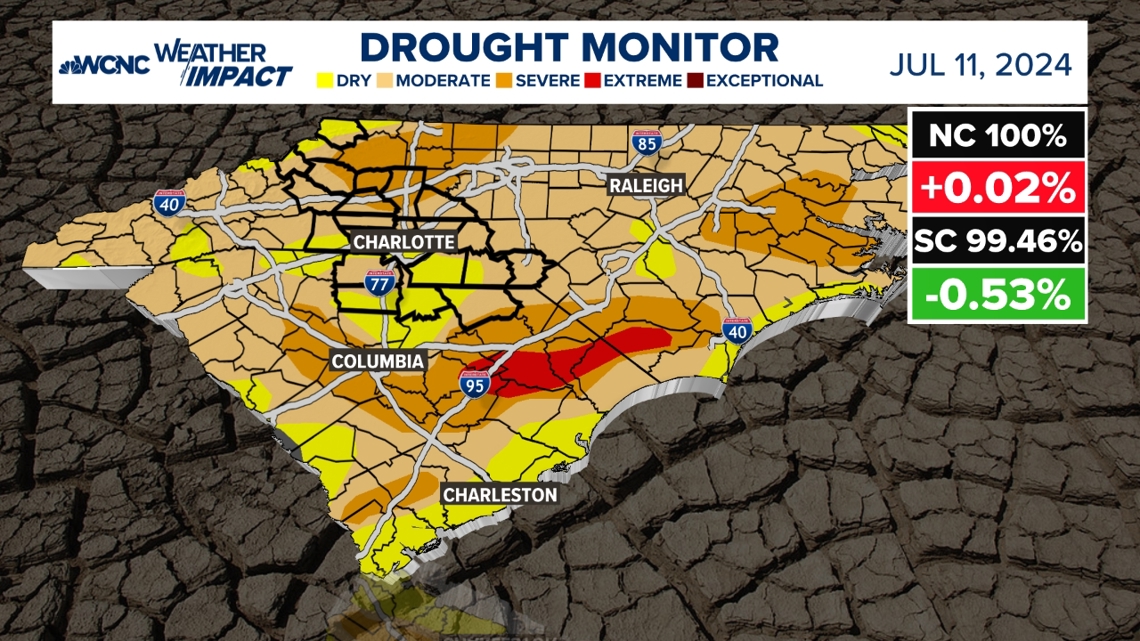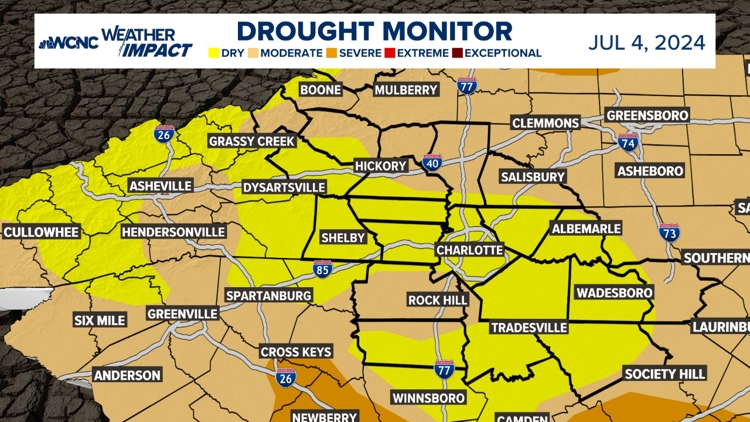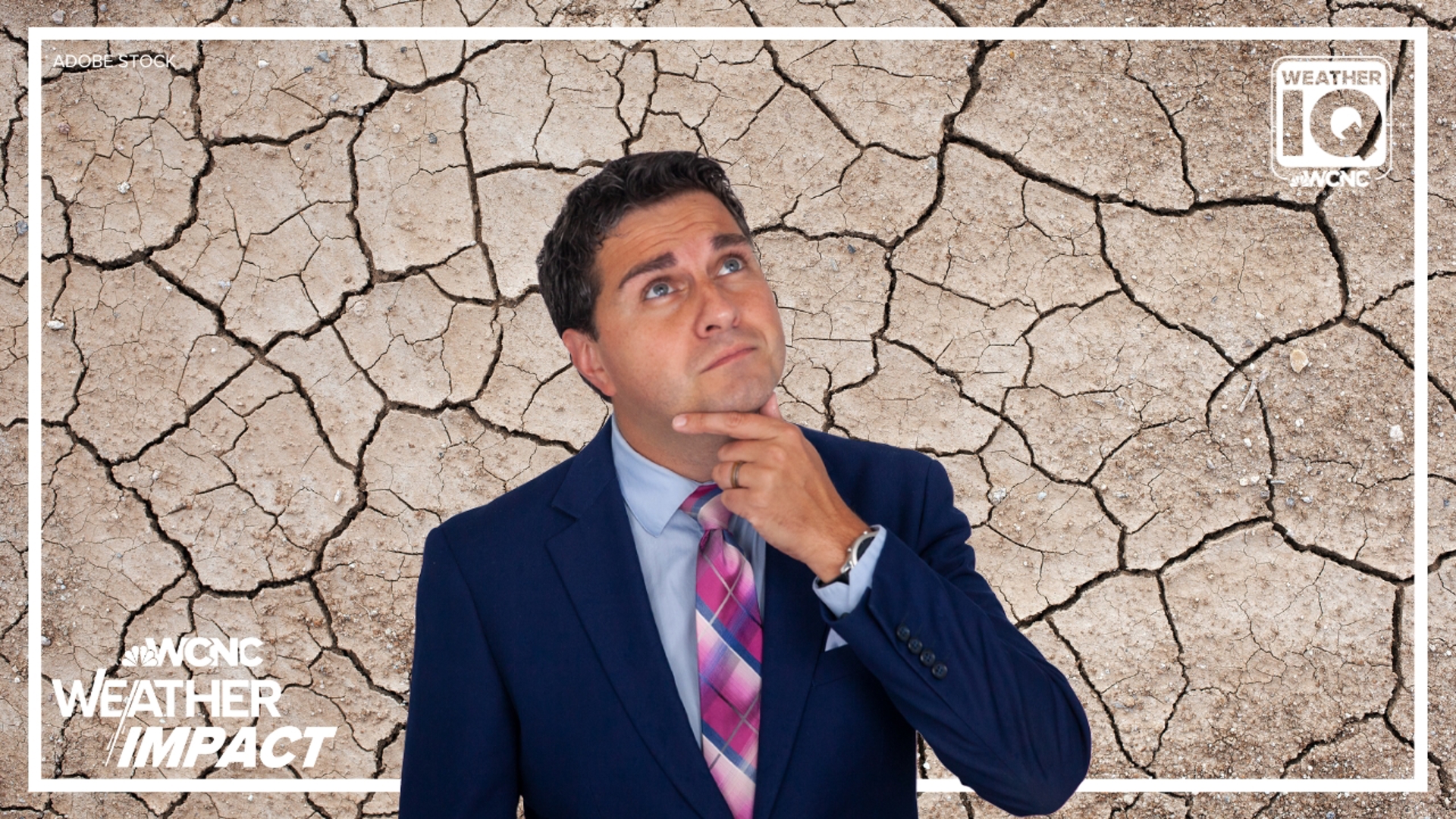CHARLOTTE, N.C. — For the first time since 2009, the entire state of North Carolina is officially in a drought.
Every Thursday, the U.S. Drought Monitor issues a map that updates the drought status for each state. North Carolina and South Carolina, are now almost entirely abnormally dry and drought-covered.
Despite heavy rain in recent days, all of North Carolina is still under drought conditions and the most recent update is mostly all bad news. The silver lining is that South Carolina saw a decrease of 0.53% of the map being covered. However, the addition of "extreme" drought status in some locations is concerning.
The Carolinas are still under a flash drought and the need for more rain has now become dire.
A flash drought, according to the U.S. Drought Monitor, is "the rapid onset or intensification of drought. It is set in motion by lower-than-normal rates of precipitation, accompanied by abnormally high temperatures, winds, and radiation. Together, these changes in weather can rapidly alter the local climate."
The most recent update - July 11, 2024


The Carolinas have had many locations over the past weekend receive over an inch of rain. The sad news is we need a minimum of 1 inch per week to prevent the drought from getting worse. We'd need several inches above the normal July rainfall to start curing it.
North Carolina Changes since July 4:
- Up 0.02% overall dry to drought. This is now 100% for the first time since 2009.
- The official drought of moderate or greater increased 13.5% to 88%.
- Severe drought went up to 20.1%. This is way up from 8.99% last week.
- For the first time, a part of North Carolina is under extreme drought.
South Carolina Changes since July 4:
- The only improvement moves 99.99% of South Carolina to 99.46% of the state under at least abnormally dry status.
- Moderate drought increased slightly by 1.6%.
- Severe drought nearly doubled in size from 16.8% to 30% of the state.
- Extreme drought now encompasses over 5% of South Carolina.
This is the worst time of year to have a drought because:
- Evapotranspiration increased: Evaporation from the soil and by transpiration from plants.
- Most plants are at their peak water need which is sucking the soil dry.
- Hotter days in the mid-to-upper 90s are forecast to continue which means the need to rain is becoming dire.
Effects of Abnormally Dry status (D0)
- Lawns are brown
- Pastures are dry
- Some crop stress
- Increased irrigation needed
For the latest weather alerts, download the WCNC Charlotte mobile app and enable push notifications.
Effects of Moderate Drought status (D1)
- Crop stress increases
- Hay production is reduced
- Trees and landscapes are drought-stressed
- Streamflow is reduced
- Lake and reservoir levels decline
- Voluntary water conservation begins
- Wildfire danger is higher than the seasonal normal
- Dryland crop yields are low
- Swimming areas and boat ramps begin to close
- Voluntary and mandatory water use restrictions are implemented,
- People are asked to refrain from nonessential water use
- Wildfires are difficult to extinguish
- Aquatic wildlife is dying
- Fewer trout are stocked
- Hay is scarce, producers are purchasing outside of the state
- Landscaping and greenhouse businesses lose revenue
- Outdoor burn bans are implemented; wildfires are widespread
- Voluntary conservation is requested even in sufficient water-level areas
- Mandatory restrictions become more severe and fines are given to violators
- Stream levels are extremely low
What needs to happen?
We need it to rain. Plain and simple.
The WCNC Charlotte viewing area is mostly under an abnormally dry status but many parts have been upgraded to moderate drought per the most recent drought monitor map shown below.
A slow soaking rain is what is ideal. A half-inch of rain over 12 hours is more beneficial than an inch over one hour.
So even though the year is up overall, the recent hot and dry conditions have made that data null and void. We will need the average July rainfall plus the June deficit to get out of this drought hole (5-7 inches of rain but not all at once).
So try and conserve water, especially if you have a well, and fingers crossed those pop-up thunderstorms become more frequent as soon as possible.
Contact Chris Mulcahy at cmulcahy@wcnc.com and follow him on Facebook, X, Instagram and TikTok.



